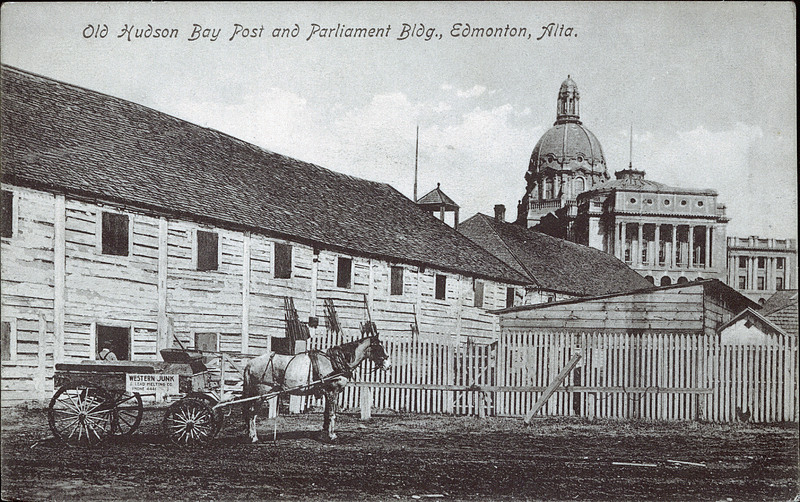RE/MAX RIVER CITY
#100, 10328 81st Ave, Edmonton, Alberta
P: 780-439-7000
F: 780-439-7248
Thursday, January 28, 2016 - This Week In Western Canadian History

Alexander Mackenzie, who was searching for an overland route to the Pacific, reached the western sea at Dean Channel, on the west coast of British Columbia, on July 22, 1793. Mackenzie mixed up some vermilion in melted grease and on a large rock wrote "Alexander Mackenzie, from Canada, by land, the twenty-second of July, one thousand seven hundred and ninety-three". The rock has been located and the words reinscribed on it. Ironically, although Mackenzie gained personal recognition as the first European to cross the Great Divide north of Mexico, the North West Company could see no practical use in the route he pioneered.
July
18
1818
The potato crop of the Red River settlers was completely destroyed in just a few minutes by a plague of grasshoppers. The loss was especially severe since potatoes were a staple in the limited diet of the colonists and their livestock.
July
24
1862
In the spring of 1862, a party of 150 men and one woman left Eastern Canada to travel overland to the gold fields of British Columbia's Cariboo district. After several months of travel, the Overlanders, as they became known, arrived in Fort Edmonton on July 24, 1862. Even at this early time, the travellers noted the scarcity of buffalo on the plains, and found that more beef than pemmican was available in the Fort's store.
July
22
1875
Prior to the development of the railroads, both the aboriginal peoples and the arriving Europeans depended on Canada's rivers to take them to the inland territories of the Canadian West. For many years, native peoples and the fur brigades depended on canoes to transport people and cargo. In 1787, the first paddle-wheel steamboat in North America appeared on the Delaware River, and the use of steam power spread to other navigable rivers. In 1873, the Hudson's Bay Company commissioned the Northcote, the pride of its fleet in her time. She measured 150 feet from bow to stern, was 28.5 feet in breadth and 4.5 feet deep. People throughout the west gathered on riverbanks to watch in wonder as she steamed by or docked at one of the settlements. On July 22, 1875, Edmontonians enthusiastically welcomed the advent of modern transportation as the Northcote became the first steamer to ascend the North Saskatchewan River as far as Fort Edmonton.
July
20
1885
The trial of Louis Riel for treason began in Regina, the capital of the North-West Territories. Riel wished to plead not guilty but, over his objections, his lawyers entered an insanity plea.
July
21
1890
[Turning Sod] A civic holiday was declared in Calgary on July 21, 1890, so the town's 2,500 residents could attend the sod-turning ceremony for the Calgary and Edmonton railway line. The line was constructed in record time and on July 27, 1891, the last spike was driven at Strathcona, south of Edmonton. Residents of both communities rejoiced: a five-day stagecoach journey was replaced by one that took only a few hours. In 1903, the C&E line was taken over by the Canadian Pacific Railway.
July
21
1908
[Mrs. Mary Boose] Because of the way that homesteads on the prairies were assigned, many of the small farms were miles away from their closest neighbours. Often the men were way, working for wages off the farms or travelling to town for supplies, and the women in particular suffered from the prolonged isolation, especially in the days before radio and telephones. On July 21, 1908, an Edmonton newspaper reported on one homesteader's wife, the mother of three, "who is hopelessly insane as the result of the lonely sojourn in the newly opened country" and who was confined to the asylum at Brandon, Manitoba.
July
23
1914
In the spring of 1914, the Japanese freighter Komagata Maru set sail from Hong Kong to Vancouver with 376 passengers - mostly Sikhs. When the ship arrived in May, only 22 of the passengers (those who had previously been in Canada) were allowed to land. The remainder were asked to leave but refused. The provision of food and water was used as a negotiating tool as discussions between the Sikhs and the Canadian government proceeded. In July, the Board of Enquiry ruled that the Sikhs could not land, and on July 23, as thousands on the Vancouver docks cheered, the Komagata Maru departed for Hong Kong.
July
18
1916
[Kootenai Brown's Cabin] One of the major figures behind Waterton Lakes National Park in southern Alberta, John George "Kootenai" Brown, was born in County Clare, Ireland, during the potato famine of 1839. After serving in India with the British Army, Brown sold his commission, and in 1861 headed for the goldfields of British Columbia's Cariboo district. After prospecting unsuccessfully for several years he decided to try his luck in the east. He rode across the prairies to Fort Garry (now Winnipeg, Manitoba) and signed on as a Pony Express rider delivering mail and supplies in the Dakota and Montana territories. In 1869, Brown married Olive Lyonnais, a Metis, and joined her people in the buffalo hunt. With the disappearance of the buffalo, Brown realised that the old way of life was ending. He and his family settled on the shores of Waterton Lake (which Brown called Kootenay Lake after the original inhabitants of the area) where he ran a small trading post and served as a guide to hunters and visitors to the region. Brown and local ranchers petitioned the federal government to protect the region so that its natural beauty could be preserved. In 1895, Kootenay National Forest was established and Brown became fishery officer and then forest ranger. In 1911, Brown's dream became a reality when Waterton Lakes National Park was created. Kootenai Brown died at his home on Waterton Lake on July 18, 1916.
July
24
1920
In a letter published in a local newspaper, a Calgary military nurse wrote of the beauty and poverty throughout Serbia, where she was stationed. The most tragic cases were the many abandoned children who had nowhere to stay, no clothes, no food, and no-one to care for them. The nurse was attempting to establish orphanages for them, but her greatest difficulty was in gaining the cooperation and assistance of the many different ethnic groups who couldn't forget their life-time distrust of each other.
July
21
1928
Jack Hornby, an Englishman, was an almost legendary figure in the Barrenlands of Canada's Northwest Territories, living by trapping and hunting, and preparing notes on the flora and fauna of the north for a book that he planned to write. In 1925, on a trip down the Thelon River, Hornby discovered a site that he felt would be ideal for a cabin. He returned to the site in the summer of 1926, accompanied by a young relative and another companion. Nothing more was heard from the party until, on July 21, 1928, four surveyors discovered three bodies at the deserted cabin. Inside the stove was the diary of Edgar Christian, Hornby's young English cousin. It told how the three had reached the spot, and had constructed a log building.
The first few weeks went well, but by November the hunting was poor and the food supply running low. On Christmas Day, Christian's diary told of the frugal meal of bannock, with all hoping that they would catch enough game that they would not regret the meal in a month. The temperatures were often in the mid -30s, with strong north winds blowing. Although Christian tried to remain optimistic, Adlard blamed Hornby for the situation and the two fought constantly. Food remained scarce. On April 16, after weeks of suffering, Hornby died and, on May 4, Christian wrote of Adlard's death. Christian continued his diary until his final entry on June 1 noted that he was too weak to walk and could not even fetch wood for the stove. He wrote letters to his family and put them with his diary and Hornby's will into the cold stove. Edgar Christian then crawled into his bunk, pulled up a blanket, and died.
July
19
1938
Calgary physicians were advised to be more careful in locking up medical supplies after a local doctor's car was broken into and morphine, codeine, and hypodermic syringes were stolen from it. Police warned that unscrupulous individuals were known to follow doctors as they made their visits to patients and take advantage of any opportunity to steal drugs for their own illegal purposes.
July
20
1945
The first family allowance payments were sent to Canadian families. Critics of Canada's first universal welfare program called it a waste of money, claiming it would encourage poor families to procreate.
July
19
1951
Due in large part to a decreasing work week, Canadian sporting goods manufacturers had more than quadrupled production in less than 10 years. The previous year's output included over 120,000 dozen golf balls, valued at $500,000; billiard and bowling supplies valued at more than $1,500,000; and hockey skates and sticks with a value of more than $3,000.000.
July
21
1954
Biologists for the Canadian Wildlife Service announced they had discovered the summer nesting grounds for the whooping crane in Alberta's Wood Buffalo National Park, but declined to identify the exact location for fear that the birds might be disturbed. Biologists had tried for years to follow the cranes throughout their breeding cycle, but the birds always managed to elude them. At the time, only 24 birds were known to exist in the world, and six of those (with young) were spotted as the Wildlife Service conducted a survey of the park's buffalo population. In 1994, 133 whooping cranes nested in Wood Buffalo, and although the bird is still listed as endangered, continued protection of its habitat and a programme to release captive cranes back into the wild hold promise that the population will continue to grow.
July
20
1985
The Alberta Court of Queen's Bench fined former school teacher James Keegstra $5,000 for promoting hatred against Jews. Keegstra taught his Eckville, Alberta, students that the Holocaust didn't happen and that an evil Jewish conspiracy controlled world affairs. The Alberta Court of Appeal overturned the verdict three years later, and in 1990 the Supreme Court of Canada agreed there should be a new trial. A second jury convicted Keegstra in 1992.
July
23
1987
For many thousands of years, Plains Indian tribes used buffalo jumps to slaughter the bison that they needed to survive. Using various decoy techniques, the hunters rounded up herds of buffalo and stampeded them over cliffs. Others waited below to kill and butcher the animals. According to Peigan legend, the Head-Smashed-In site, in the Porcupine Hills in southwestern Alberta, was named for a young Peigan boy who wanted to watch the animals as they plunged over the cliff. He stood under the shelter of a ledge as the buffalo flew past him, but then was trapped between the bodies of the animals and the cliff. He was found by his family with his skull crushed by the weight of the buffalo. The site was first excavated in 1938 and designated a provincial historic site in 1979 and a UNESCO World Heritage site in 1981. On July 23, 1987, the Head-Smashed-In Buffalo Jump Interpretive Centre was officially opened by the Duke and Duchess of York.
Archives
Categories
